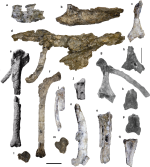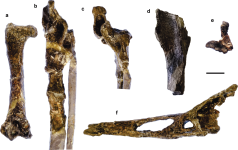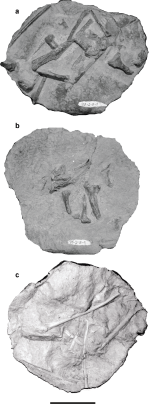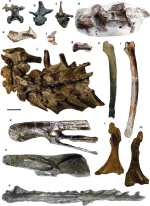The Antarctic record of Cretaceous birds
Antarcticavis capelambensis Cordes-Person, Acosta Hospitaleche, Case et Martin, 2020
A partial skeleton (SDSM 78147, cast SDSM C-642) collected during the summer field trip to West Antarctica in 1998 in Maastrichtian sediments of the Snow Hill Island Formation (Locality V9945, Cape Lamb, Vega Island; Figure 1a) is the only specimen known of Antarcticavis capelambensis (Figure 1). This skeleton is composed of two thoracic vertebrae, the partial sternum, the articulated right coracoid and scapula, the distal left coracoid, the right humerus, a right ulna and radius still articulated, the proximal right carpometacarpus, proximal and distal left carpometacarpus, the synsacrum, both incomplete femora, the proximal right tibiotarsus and fibula, the distal end of both tibiotarsi, and the proximal right tarsometatarsus (Acosta Hospitaleche et al., 2018)
Despite the recovery of many bones from the skeleton, some of them still being articulated, the preservation of the remains is not good enough to facilitate further comparisons. Numerous features, such as the cranially deflected deltopectoral crest of the humerus, the small acrocoracoid and procoracoid process lacking an incisura for n. supracoracoidei, and the expanded facies articularis externalis of the coracoid, relate
Antarcticavis and the neornithine birds. However, as this specimen belong to an adult bird, certain features such as the enlargement and pneumatization of the humeral head (only partially observed), along with the absence of a supratendinal bridge Despite the recovery of many bones from the skeleton,
some of them still being articulated, the preservation of the
remains is not good enough to facilitate further comparisons.
Numerous features, such as the cranially deflected deltopectoral crest of the humerus, the small acrocoracoid and procoracoid process lacking an incisura for n. supracoracoidei, and the expanded facies articularis externalis of the coracoid, relate
Antarcticavis and the neornithine birds. However, as this specimen belong to an adult bird, certain features such as the enlargement and pneumatization of the humeral head (only partially observed), along with the absence of a supratendinal bridge is wider than the medialis, and sulcus intercondylaris is about one third of the cranial surface width. Notably, the fibula is not reduced, and the tarsometatarsus exhibits a with well-developed sulcus hypotarsi (Cordes-Person et al., 2020). These features serve to differentiate
Antarcticavis from other Cretaceous birds from Antarctica like
Polarornis gregorii and
Vegavis iaai.
Figure 1 Antarcticavis capelambensis SDSM 78147 (holotype). a, two articulated thoracic vertebrae in lateral view; b, sternal keel in lateral view; c, right coracoid in ventral view; d, synsacrum and right femur in right view; e, proximal and distal halves of left humerus in caudal view; f, right humerus in cranial view; g, right scapula and coracoid in dorso-medial view; h, left coracoid in ventral view; i, left radius and ulna in dorsal view; j, proximal end of right ulna in ventral view; k, distal end of right tibiotarsus in caudal view; l, proximal end of right carpometacarpus in ventral view; m, proximal end of left carpometacarpus in ventral view; n, left femur in caudal view; o, proximal end of right tibiotarsus and fibula in cranial; p, distal end of right tibiotarsus in cranial view; q, proximal end of right tarsometatarsus in cranial view. Scale bar represents 10 mm.
 Polarornis gregorii
Polarornis gregorii Chatterjee, 2002
A partial skeleton (TTU P 9265) recovered from the Maastrichtian levels of Unit 9, LBF on Seymour (Marambio) Island, which bears a resemblance to common loons (Figure 2) was briefly outlined in a short abstract by Chatterjee (1989) and subsequently expanded in Chatterjee (2002). It is important to note that the geographical position indicated on the map by Chatterjee (2002, Figure 1 in the paper) does not align with any of the sites where the Unit 9 is exposed. Our field experience suggests that TTU P 9265 likely come from a nearby locality where the bird-bearing levels of Unit 9 are exposed, near the northern coast of the island (Figure 1c). It is worth mentioning that older levels of the LBF emerge further west in this area on Seymour (Marambio) Island (e.g., Macellari, 1988; Montes et al., 2019)
Chatterjee (2002) provides only schematic drawings for the description of the incomplete skull, four cervical vertebrae, a sternal fragment, the left femur, a fragment of the right femur, and the proximal left tibiotarsus that constituted the holotype of
Polarornis gregorii Chatterjee 2002.
The initial phylogenetic proposal grouped
Polarornis with
Gavia based on the following synapomorphies: orbital process of quadrate with the medial surface sharply concave and an overhanging ridge, mandibular articular surface of the quadrate with a prominent caudal projection, femur strongly arched and with a proximal end anteromedially compressed, elongated cnemial crest and lateral cnemial crest distally widen (Chatterjee, 2002). However, it is important to note that the taxonomic content of the data matrix used in the analysis considered only four neognathous birds, and none of which were birds with aquatic habits like Podicipedidae or Anatidae, which would have allowed the recognition of convergent characters.
Consequently, the sister-taxa relationship between
Gavia and
Polarornis may be somewhat inevitable in this context, potentially influencing the phylogenetic hypothesis proposed by Chatterjee (2002).
Another species that Chatterjee (2002) suggested might be related to loons is
Neogaeornis wetzeli Lambrecht 1929 (Lambrecht, 1929), represented by a tarsometatarsus from the contemporaneous Quiriquina Formation in Chile. Notably, this species has been also considered as a senior synonym of
Polarornis (Olson, 1992). In subsequent years, a second skeleton from the late Cretaceous levels of Vega Island was identified as a smaller species of
Polarornis (Chatterjee et al., 2006). However, it is essential to clarify that this material was, the same second concretion that was collected with the holotype of
Vegavis iaai during 1993 (as described in Section 4.3), later designated as the second partial skeleton (MACN-PV 19748) of
Vegavis iaai in Clarke et al. (2016).
Other materials, including a small sedimentary block containing an incomplete skeleton (MLP-PV 96-I-6-2), were collected from Unit 9 of the LBF on Seymour (Marambio) Island. The specimen, assigned to
Polarornis sp., comprises the distal end of a left femur, proximal end, partial left and right tibiotarsi shaft, proximal half of right fibula, and a pedal phalanx (Acosta Hospitaleche and Gelfo, 2015; Reguero et al., 2013). Additionally, isolated and very fragmentary materials (MLP-PV 98-I-10-47, incomplete tarsometatarsus; MLP-PV 98-I-10-50, incomplete right tarsometatarsus; MLP-PV 98-I-10-52, incomplete left tarsometatarsus; MLP-PV 98-I-10-76, incomplete right tarsometatarsus; MLP-PV 98-I-10-51, proximal end of left femur; MLP-PV 98-I-10-60 and MLP-PV 98-I-10-61, distal end and partial corpus of pedal phalanges; MLP-PV 98-I-10-48, distal end of left tibiotarsus; MLP-PV 98-I-10-59, diaphysis of left tibiotarsus) from Vega Island (Sandwich Bluff Member, LBF) might belong to Gaviiformes according to Acosta Hospitaleche and Gelfo (2015) or some other Gaviiformes-like group that remains undetermined. A similar situation applies to poorly preserved remains from the Sandwich Bluff Member of the LBF, Vega Island (MLP-PV 98-I-10-54, incomplete left tarsometatarsus; MLP-PV 98-I-10-27, incomplete right tarsometatarsus; MLP-PV 98-I-10-53, distal end of left tibiotarsus; MLP-PV 98-I-10-49, distal end of right tibiotarsus) and from the Unit 9 of the LBF, Seymour (Marambio) Island (MLP-PV 00-I-10-1, pedal phalanx).
Unfortunately, it is not possible to advance in the systematic determination of these remains until more complete material can be examined. The current state of knowledge allows further comparisons with all the
Vegavis specimens, the holotype of
Antarcticavis, and some other non-Antarctic Cretaceous neornithine-like birds, providing a new perspective to analyze the phylogenetic relationships of
Polarornis.
However, several outstanding questions remain regarding the anatomy and the original interpretation and codification of the morphological character-states of
Polarornis. This is partly because this species was studied primarily from images and the detailed description provided by Chatterjee (2002) is confusing in some respects when the fossils are examined directly
Figure 2 Polarornis gregorii TTU P 9265 (holotype) and MLP-PV 96-I-6-2. a, left femur in caudal view; b, proximal left tibiotarsus in cranial view; c, proximal left tibiotarsus in lateral view; d, proximal left tibiotarsus in cranial view; e, undetermined bone fragment; f, skull in lateral view. Scale bar represents 10 mm.
 Vegavis iaai
Vegavis iaai Clarke, Tambussi, Noriega, Erickson et Ketcham, 2005
Vegavis iaai is represented by the holotype (MLP-PV 93-I-3-1, Figures 4–6), a second partial skeleton (MACN-PV 19748, formerly MLP-PV 93-I-3-2), and an isolated femur (SDSM 78247). The holotype is based on a partial skeleton that was found in the Sandwich Bluff Member of the LBF, exposed at the locality IAA VEG 9303 of the Vega Island (Figure 1a) by members of the Instituto Antártico Argentino (Clarke et al., 2005, 2016; West et al., 2019). Despite that, the preliminary examination was made with most of the bones included into matrix in a concretion divided into two halves (Figure 4), and affinities with the Anseriformes were recognized, mainly based on the anatomy of the right humerus and the left tibiotarsus (Figure 5. In consequence, the fossil was assigned to Presbyornithidae (Noriega and Tambussi, 1995). A latex peel 93-I-3-1 CA (Figure 3c), currently housed with the holotype, was made at this instance on one of the halves, in which also part of the left humerus, distal right radius, right coracoid, synsacrum, proximal and distal ends of both femora, proximal left and distal right tarsometatarsi, and six ribs were exposed.
The subsequent partial extraction of the bones (proximal left humerus, right coracoid, partial pelvis, and proximal femora) from the concretion allowed the first analysis in a phylogenetic context, the proposal of a generic and specific name for this specimen, and a new taxonomical proposal. The name
Vegavis iaai was given to this specimen allocated within Anseriformes, in the clade Anatoidea with Anatidae and Presbyornis (Clarke et al., 2005). The comprehensive analysis of Clarke et al. (2005) included the volume rendering of the bones preserved within the matrix using CT scan images for scoring new characters and the analysis of the histological section of the radius for further comparisons with other Anseriformes. The bones included in the second half of the concretion (cervical and thoracic vertebrae, proximal right humerus, right radius, left ulna, left scapula, ribs, synsacrum, pelvis, distal left femur, and both fibulae), were examined through this technique.
The second skeleton, which was still within the sedimentary matrix, was prepared many years later, and assigned to Vegavis iaai. Minor variations were observed during the comparisons with the holotype (Figures 4 and 5), mainly referring to the larger size of MACN-PV 19748 (Clarke et al., 2016). This specimen provided a new opportunity to advance in the acknowledgment of the anatomy of basal neornithine birds, based on elements not preserved in the holotype, such as the syrinx, the pterygoid, the posterior portion of the mandible, two articulated portions of the cervical and thoracic vertebrae and free caudals, distal portions of the right ulna and radius together with the radiale and the ulnare, right carpometacarpus with some of the phalanges, and an element preliminarily assigned to the patella (Clarke et al., 2016). The analysis of a more complete dataset including both specimens of
Vegavis iaai, positioned
Vegavis within Galloanseres but outside Anseriformes (Worthy et al., 2017).
The new family Vegaviidae was erected by Agnolín et al. (2017) based on the similarities observed among
Vegavis iaai,
Polarornis gregorii,
Neogaeornis wetzeli (a partial tarsometatarsus from the Maastrichtian Quiriquina Formation, Chile), and
Australornis lovei (a partial coracoid, scapula, and wing from the late early Paleocene Waipara Greensand, New Zealand). Vegaviidae was recovered as a basal clade of Anseriformes characterized with an austral distribution during the late Cretaceous and Paleocene (Agnolín et al., 2017). This idea provoked a quick reaction in most of the paleornithological community, which not only disapproved the taxonomic composition of this clade (Mayr et al., 2018) but also deeply disagreed with many of the anatomical observations made by Agnolín et al. (2017). However, more recently,
Vegavis was recovered as the sister taxon of the new species
Maaqwi cascadensis McLachlan, Kaiser and Longrich 2017, from the Late
Campanian Northumberland Formation of Canada.
Although no other Vegaviidae (sensu Agnolín et al., 2017) was included in the data matrix analyzed by McLachlan et al. (2017), the clade
Maaqwi cascadensis +
Vegavis iaai was interpreted as Vegaviidae (McLachlan et al., 2017). The proposals of Agnolín et al. (2017) and McLachlan et al. (2017) are not comparable regarding their taxonomic composition. In the original proposal (Agnolín et al., 2017), Vegaviidae would be an austral family with a biochron
spanning from the Maastrichtian to the Danian. On the contrary, in the second proposal, Vegaviidae would be a family more widely distributed, both geographically and temporally, and certainly not with an austral origin as it was originally proposed (McLachlan et al., 2017). In any case, it should also be considered that this last phylogenetic proposal results from the analysis of a data matrix modified from Longrich et al. (2011) that would be much more appropriate to analyze stem birds rather than Neornithes.
Almost simultaneously, and after three years of hard work, the holotype of
Vegavis was completely removed from the sedimentary matrix in the División Paleontología Vertebrados of the Museo de La Plata. As a result, a total of 36 new features could be scored in that instance, and a new phylogenetic analysis was performed (Acosta Hospitaleche and Worthy, 2021). Although new anatomical details were described, particularly in the pelvis, synsacrum, tarsometatarsus, and humerus, the phylogenetic results did not show a major resolution in comparison with previous proposals using the same set of characters (Worthy et al., 2017). The results
recover
Vegavis within Galloanseres again (Acosta Hospitaleche
and Worthy, 2021), but not within Anseriformes, as was proposed by Clarke et al. (2005, 2016).
A third specimen (SDSM 78247) is represented by an isolated femur (West et al., 2019) that has been previously interpreted as an indeterminate Cariamiformes (Case et al., 2006). It was assigned to
Vegavis sp. after a detailed examination and the comparison with the holotype MLP-PV 93-I-3-1 and MACN-PV 19748. The differences with
Polarornis (see next paragraph) were also highlighted by West et al. (2019) taking advantage of the preservation of this bone in all those skeletons.
The phylogenetic position of
Vegavis was re-evaluated by Field et al. (2020), in the study of
Asteriornis maastrichtensis from the Maastrichtian of Belgium. Important variations in the phylogenetic position of
Vegavis iaai were observed, depending on the optimization criteria applied in the analysis and the addition of molecular data in the Bayesian analysis of the same data matrix (modified from Worthy et al., 2017). Under maximum parsimony,
Vegavis was recovered as the sister taxon to Neornithes; while in the Bayesian analysis, it appears in an unresolved position at the base of Neognathae (Field et al., 2020).
Finally, a thoracic vertebra of an unidentified ornithurine bird (AMNH FARB 30920) from the upper Cape Lamb Member, an incomplete coracoid of an unidentified bird (AMNH FARB 30898) from the same level that the Vegavis holotype (Sandwich Bluff Member 1 sensu Roberts et al., 2014), and a distal tarsometatarsus of an indeterminate ornithurine (AMNH FARB 30913) from the overlying SBM (according to Roberts et al., 2014) could belong to either
Vegavis or
Polarornis (Roberts et al., 2014). They could only be evaluated when more complete materials are available for comparison. The current scenario is promising for the advances in the field for the following years.
Figure 3 Vegavis iaai MLP-PV 93-I-3-1. a–b, holotype within the sedimentary concretion before mechanical extraction of the bones; c, latex peel MLP-PV 93-I-3-1 CA.

Figure 4 Vegavis iaai MLP-PV 93-I-3-1 (a–c, h, k, m–o) and MACN-PV 19748 (d–g, i–j, l). a, ninth cervical vertebra in dorsal view; b, third thoracic vertebra in cranial view; c, fourth thoracic vertebra in cranial view; d, cervical vertebra in dorsal? view; e, articular region of right mandible in medial view; f, caudal vertebra in dorsal? view; g, left pterygoid; h, left scapula in lateral view; i, left scapula in lateral view; j, thoracic vertebra series in dorsal view; k, right ossa coxae in medial view; l, left coracoid in ventral view; m, right coracoid in ventral view; n, left ossa coxae in medial view; o, synsacrum in ventral view. Scale bar represents 10 mm.

Fred








